

UPDATES:
March 17, 2008 - Updated the internal pictures with pictures of a production unit (previous pictures were of a beta sample) and added link to OPPO Digital player comparison.
March 19, 2008 - Several screen shots have been added, two under "Setup" (one for the General Page and one for the Speaker Page) and two under "Audio" (one for CD playback and one for SACD playback). The CD playback shot also shows the default background image, and the SACD playback shot shows the file browser interface that is shared with the USB interface and CD-R/DVD-R data discs.
My experience with OPPO Digital and their DVD players began in May 2005 with my purchase of their first player, the OPDV971H. Starting in late 2006, I did some beta testing for them on the 971H's replacement, the DV-981HD, and in mid-2007 I helped test the DV-980H. When they mentioned having another DVD player in the pipeline and asked if I'd be willing to help kick the tires on it as well at some point, I didn't hesitate to volunteer. A couple months later, FedEx delivered a beta sample of what may very well be the last DVD player that OPPO Digital ever develops: the DV-983H. With video processing chips from Anchor Bay Technologies and a price tag of $399, it is a flagship player that appears positioned as OPPO's final statement on standard DVD players. Blu-ray's recent success in the HD format war will likely drive anything else that they develop. As in my previous equipment reviews, you can find an equipment list at the end of this review.
(Added 3/17/2008) A few days after I posted this review, I completed and posted an article aimed at comparing the three current OPPO Digital players: the DV-980H, the DV-981HD, and the DV-983H being discussed here. You can find that article here.
I've spoken in previous reviews about OPPO's packaging, and the 983H retains the packaging found on other OPPO products. Sturdy foam blocks and a fabric bag have once again delivered a player from California to Tennessee without incident, and the 983H was accompanied by an HDMI cable along with the basic AV cables, power cord (a detachable IEC type), and the remote. The faceplate shows clear signs of the 980H's influence, with the same basic shape, same disc tray (although the drive itself is different), and same (or very similar) display. The button layout has changed somewhat, and the 980H's navigation pad has been dropped. In its place is a row of three buttons that harken back to the controls found on the front panel of the 971H and 981HD. I still like the design of the 980H's front panel a great deal, even though I almost never used the navigation pad when the 980H was in my den. The move from a plastic faceplate to aluminum (including an aluminum front on the disc tray) gives the player a nice touch of heft and solidity, something that a DVD player deserves when you reach this price point. In spite of an initial preference for the 980H's aesthetics, the 983H grew on me – at this point, I'm not sure which player's industrial design I prefer, but if I had to pick one I'd pick the 983H.
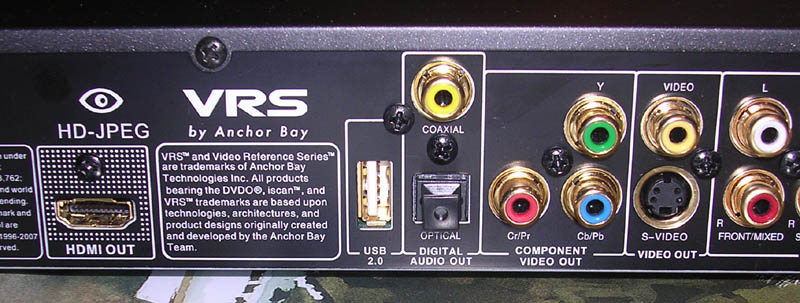
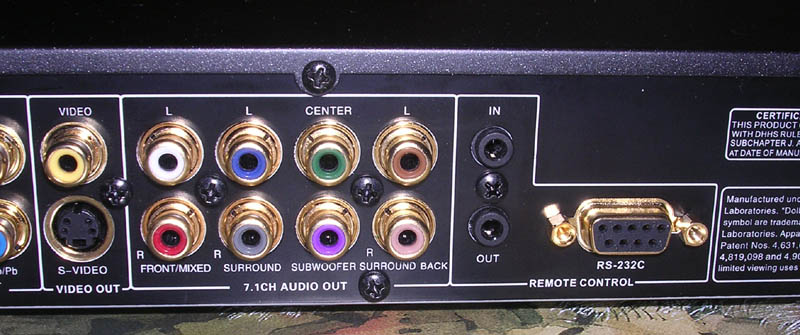
Partial rear panel
The 983H is OPPO's most expensive DVD player to date, and much of that cost is due to the use of a pair of video processing chips from Anchor Bay Technologies: the ABT102 for deinterlacing and the ABT1018 for scaling. These chips are the same ones used in ABT's iScan VP30 video scaler. These chips are only used with the player's HDMI output. If you aren't using that output for your video connection, you may be better off with the less expensive 980H (both players use a Mediatek chip for providing a video signal to the component output, offering 480p for copy-protected discs and up to 1080p for other sources, with the 980H using that chip for HDMI output as well). The audio side of the equation has a few more options. For DVD and CD playback (and for the various audio and video files that can be played back from CD-R, DVD-R, and USB devices), the coaxial and optical outputs will cover your needs just fine. Of course, the HDMI output will also handle that if you have a receiver with support for HDMI audio. DVD-Audio and SACD add a wrinkle to the equation. If you are like me and don't have HDMI v1.1+ support in your receiver, then you'll need to connect the player's multichannel analog output and use the corresponding input on your receiver to play those discs. Once again, though, HDMI v1.1+ support at the receiver will allow you to rely solely on the HDMI connection for your audio needs. Unlike the 980H, however, DSD output over HDMI is not available due to restrictions imposed by the ABT chips being placed in the HDMI signal path. Below are a few interior images, showing the overall interior, a closer look at the Mediatek chip, and a look at the power supply section with the cage removed. A couple other close-ups can be found later in this review. In my system, I connected HDMI, coaxial, and 7.1 analog to my Outlaw Audio Model 990 surround processor for my day-to-day needs. I also connected s-video, composite video, and component video cables for testing.
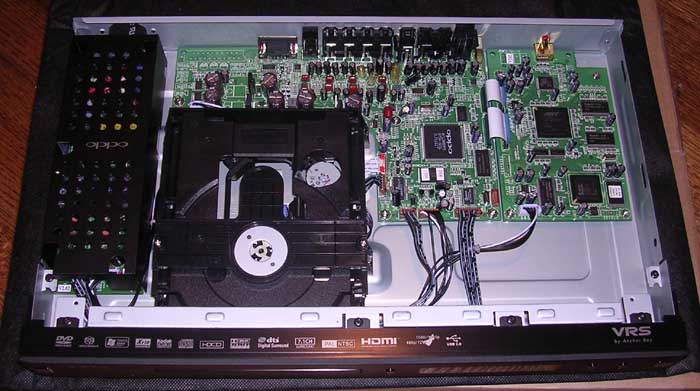
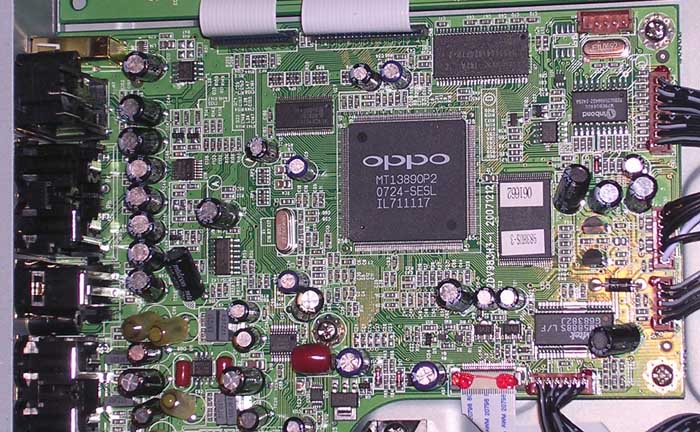
DV-983H's Mediatek chip
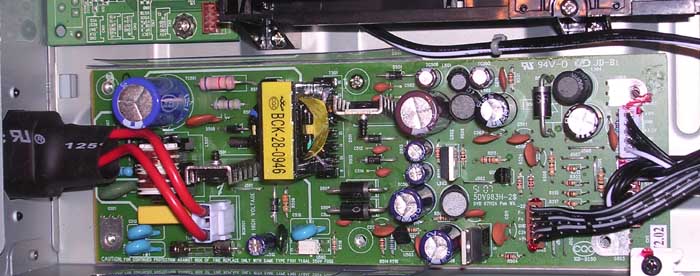
DV-983H power supply
The 983H's video processing chips were first seen in standalone video processors that offered a nearly limitless number of output resolutions, but some readers will notice that we see only the traditional standard HD resolutions (720p, 1080i, and 1080p) offered here. There is a reason for this. OPPO is not providing user-defined custom resolution setup with the 983H because such resolutions reqire proper clock timing, and thus the addition of external clock synthesizers which are difficult for typical users to set up properly. Instead, OPPO plans to work with ABT to develop pre-defined output timing for a set of common "custom" resolutions. Even then, compatibility with different displays is likely to be a concern because there is no industry standard to rely on for these resolutions. As a result, whatever firmware is developed will almost certainly be made available as "public beta" firmware and not included in the production firmware.
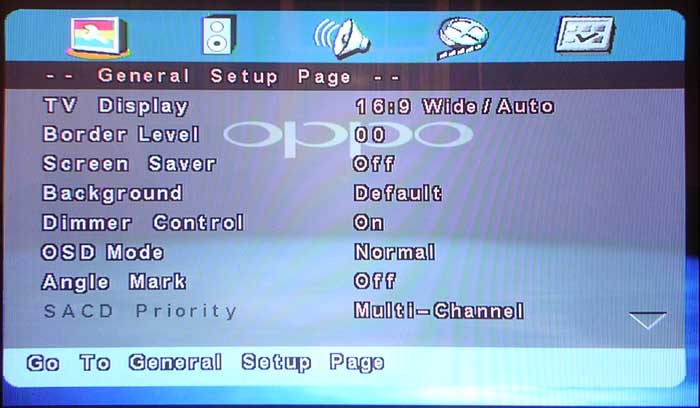
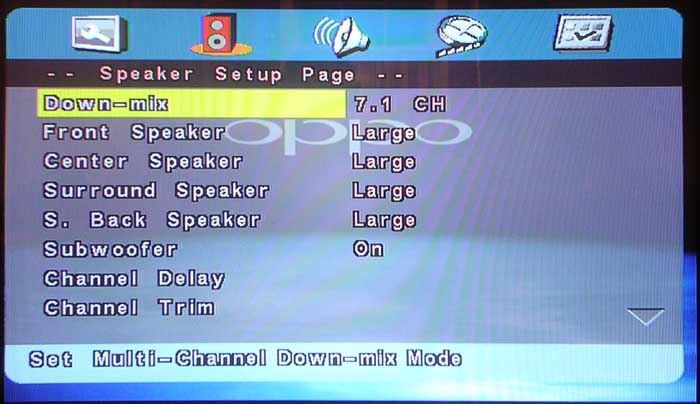
The Audio Setup menu includes a couple options that are worth mentioning at least briefly. First on the list is "HDMI Audio." HDMI Audio defaults to "Auto," meaning that Dolby Digital and DTS signals are passed as raw, undecoded bitstreams while DVD-Audio and SACD are output as multichannel PCM. You can also select "PCM" and the 983H will decode everything internally and output either multichannel PCM or stereo PCM via HDMI, or you can select "Off" to disable HDMI audio output entirely. Unlike the 980H, the 983H does not offer DSD output of SACD's over its HDMI connection. In that regard, the 983H provides the same solution as the 970HD and 981HD: DSD is converted to PCM and output over HDMI that way. Next is the "Digital Output" setting, which determines what form the signal coming from the optical and coaxial outputs will take. I would recommend leaving this set to "Raw" for almost every situation, as "PCM" will cause the player to convert multichannel sources such as Dolby Digital 5.1 and DTS 5.1 to a stereo signal. There are also some options for the Pro Logic II decoding, which I will touch on under the Audio Playback section later in this review.
The Video Setup page of the 983H offers an abundance of controls, more than any other DVD player that I've owned. First is a newcomer to OPPO players, "Primary Output." Setting this to HDMI will help the 983H activate the HDMI output even if other portions of the HDMI signal path are not turned on yet. The myriad of other settings relate to picture adjustments of various types. One question that often arises is whether to adjust the player's brightness, contrast, and hue settings when calibrating the system or whether to adjust the display's settings. As has been wisely suggested by others in the past, I recommend making adjustments only at the display if at all possible and only adjusting at the player if it is necessary. I will also point out that calibrating your video using a disc like Digital Video Essentials, AVIA, or GetGray is well worth your while. Having said that, it's worth recognizing that the 983H provides an unusual array of controls, due in large part to the use of a powerful pair of video processing chips. As a result, there is more reason than usual for looking at the options in this menu. I recommend leaving everything at the default settings initially for calibration, but I also recommend taking a look at OPPO's manual for a good (and pretty detailed) overview of the options available in this menu.
As I mentioned earlier, the Preferences Page is only accessible when there is no disc active. What I didn't say was that there are relatively few cases where you will need to make changes here. The controls for default audio, subtitle, and disc menu languages as well as parental controls can be found here. It also includes controls for specifying NTSC or PAL video output. Since most users will want to stick with the default of NTSC, that setting also can be left alone the vast majority of the time. If you do have a PAL display, however, you'll want to pay a visit to this screen.
Roughly four and a half years ago, I started using a Universal remote to control my system. Initially I used an MX-500, but about two years later I switched to an MX-700. For others with the MX-700 or similar remotes (MX-750, MX-800, MX-850), I've posted both a 983H device file and my overall system file. The 983H device file can't be opened directly from the editing software – you'll need to right-click on a device under "Home" on the left side of the screen and choose "Import Device" to bring the configuration file into your file. Note also that the "OSD" button (which scrolls through display options for track, chapter, and time details) is mapped to the MX-700's "Info" button while the "INFO" button (which pulls up a screen of information such as disc format, audio details, and bit rate) is mapped to "Guide."
There are a few other basic setup and operational tips and tricks floating around that apply to all of OPPO Digital's players. If you've used other OPPO Digital players, this may be old news, but others who are new to the company likely haven't heard it before. First, there is an undocumented feature often called "Direct Play" that will allow you to skip most of the warnings, previews, ads, and other junk at the start of a disc. As soon as the DVD will allow, press "STOP" and then press "MENU." "Direct Play" may appear briefly on the screen, after which the movie menu should appear. Another undocumented feature that has seen a lot of use among OPPO owners is the region code control. By default, the 983H is a Region 1 player, as is required of players sold in the US and Canada. The 983H can be changed to work with any other region code, however, and it can even be set to "0" (in which case it will work with all regions). To change the region code, first stop disc playback andpress Setup on remote control to access the setup page. Once in the setup menu, enter 9210 on the remote. A menu will pop up allowing you to specify a region, and you can select any number from 0 to 6. Once done, press "SETUP" on the remote again. The 983H's remote also has a button (labeled "Capture") that will allow the user to replace the "OPPO Digital" splash screen with a screen shot – just press the Capture button while the image you want is on screen and it will replace the default screen with that screen shot.
OPPO Digital has provided firmware updates for their players regularly. The updates cover everything from bug fixes to refining picture quality to adding features. As firmware is released for the 983H, I'll try to update the end of this section with details. To begin with, I'll include a little information on the process for installing new firmware. If you want to find out the firmware version currently installed, power on the player with no disc inserted. Once the player is on, press "OSD" on remote and note the popup on the screen. The "Batch" notation will be the firmware level. The new firmware will overwrite any changes you made to the settings previously (TV display, HDMI output resolution, speaker settings, and so forth), so you'll want to take a minute to run through the 983H's menus and get things dialed back in before you toss in a DVD to try out the new firmware. It might even be handy to write down your settings before the firmware update.
Some of the details for installing new firmware will be borrowed from my reviews of the 981HD and 980H, since the process is the same for those players as well. The 983H's firmware can be updated via either CD-R or USB. The first step to updating via CD-R is to download the ISO image file from OPPO Digital. This file will be a bit less than two megabytes in size. Once you have the ISO file, you'll need to use a CD burning program like Nero to burn that file to a blank CD-R. When you do this, you need to make sure to select the option to "burn image to disc" in order for the disc to work properly. If you don't have any CD burning software installed or are unsure of how to properly burn an image file with your software, you can download a free program such as ImgBurn that will burn the firmware image file to a blank CD-R (assuming, of course, that you have a CD-R drive). To burn an image file with ImgBurn, select "Write" from the Mode menu, insert a blank disc in the CD-R drive, and click on the "Browse for a file" icon at the top of the Source section of the screen (next to the note "Please select a file..."). This will bring up an Open dialog so that you can select the ISO image file downloaded from OPPO's site. After you've done this, you can select the "Write" button at the bottom left corner of the window and the program will burn the firmware data to the blank CD-R. Once you have your CD-R in hand, you just drop it in the player. You will be prompted to press "Play" to begin the firmware update, and after you do that the player will begin to read the new firmware off the disc. After it has the data, it will eject the disc and ask you to remove the disc from the tray. Do that, but do not close the tray or turn the player off because the player needs time to load the new firmware (there will be a message on the TV reminding you of this). When it is complete, the tray will close and the player will reboot. At this point, the new firmware is installed.
The 983H also offers a second means of updating firmware: via the USB input. You can download the firmware (as a .BIN file), put it on a USB device such as a memory stick, and update the firmware in this way. This approach avoids needing to worry about burning an ISO file to CD-R properly and spares you a blank CD-R. Once the firmware begins to install (when the display is counting from 01/32 up to 32/32), remove the memory stick so that the player won't try to re-start the update when it's done.
Check back here for updates to the review as firmware updates are released.
As a flagship DVD player, the 983H's video performance is central to the success or failure of the entire player. The basic tools employed (customized version of the Mediatek decoder, Anchor Bay ABT102 for de-interlacing, and Anchor Bay ABT1018 for scaling) provide a very solid foundation on which to build. (See below for a picture of the HDMI output board – if you are looking for the ABT102 chip, it's the one labeled "Xilinx Spartan" and is located on the right side of the picture.) The 983H takes that foundation and makes extremely good use of it, providing the best picture I've seen yet from a DVD player. Others will presumably offer more detailed analysis of the minutia (as can be done when using larger displays than my CRT provides), but my experience matches closely with the results reported by Secrets of Home Theater's recent benchmark test, which awarded the 983H the first perfect 100 score ever for a standalone DVD player. Picture quality is simply excellent. Layer changes are extremely quick. I've heard that the 983H's layer changes are not quite as fast as found in some previous OPPO players, but they are still fast enough that I had to get out a title with a known layer change location and look for the layer change to notice it.

As with other OPPO players, the 983H offers a button on the remote labeled "GOTO" that when pressed repeatedly toggles through a series of options for direct access to a specific track or time on the disc. This is a feature that was very difficult to use on my Yamaha DVD-S1500, but it's really quite convenient on the 983H. Depending on the type of disc in use, you can go directly to a specific title, chapter, elapsed time position, or track. Other typically basic features that are included are repeat (allowing you to repeat a disc, title, chapter, track, or between any two points "A" and "B"), direct selection of the active audio track or subtitle track, variable speed slow motion, and video zoom. The video zoom feature has been heavily expanded compared to earlier OPPO players, however, as it is now handled by the ABT chip. Available zoom options will vary depending on the TV display setting that is selected in the setup menu. New options include a stretch zoom designed to be used with anamorphic lenses (allowing 2.35:1 movies to be stretched vertically to eliminate the letterbox bars, which can in turn be stretched horizontally by an anamorphic lens to preserve the proper aspect ratio) and a "full screen" zoom that zooms by 1.33 to eliminate 2.35:1 letterbox bars at the expense of cropping off the left and right edges of the image. The latter zoom can also be used in conjunction with 4:3 content to zoom in enough that the pillarboxing is eliminated at the expense of the top and bottom edges of the image. There is also an "underscan" zoom level that shrinks the image by 5% (creating a thin border around the entire image) to allow users to compensate for TVs that overscan. There are also an assortment of basic magnification levels (1.2x, 1.5x, 2x, 3x, 1/2x) available. This full array of zoom options is only available with the HDMI output, as the component output does not have the benefit of the ABT processing and is limited to 1.0x, 2.x, 1.5x, 2x, 2.5x, and so on.
OPPO players have always made use of their Mediatek chip's support for an assortment of audio, video, and image file formats. Supported formats include MP3, WMA, JPG, Divx, Xvid, and VOB. These files can be stored on a CD-R or DVD-R, but they can also be stored on a USB mass storage device such as a memory stick or an external hard drive (as long as the device is formatted as a FAT or FAT32 partition). No matter which media is used to store them, the Mediatek chip's file interface has a limit to the number of files it can read and access. The maximum is 700 files. Anything beyond that will not be accessible. Long file and folder names are supported, and the text of a long name will scroll past if necessary to give you a complete view. Also, ID3 tags for MP3 files are displayed in the right window of the file manager interface. Obviously, the file limit rules out using the player as a media server for your CD library, but it can still be a handy tool.
One change that the 983H made to the 980H's basic layout is the placement of the USB port. Rather than being located on the front panel behind a cover, the USB port is located on the rear panel. This makes for a cleaner looking faceplate. It also makes having an external hard drive connected on a permanent basis much less unsightly. Several months before I received the 983H for testing, I acquired a 250GB external USB hard drive to use with my 980H. My drive came formatted to FAT32, so I didn't need to worry with formatting it, but there are a number of programs available (including the free program SwissKnife) that could help if you have an NTFS formatted drive that you want to use for this purpose. I've used this drive mainly to play back .VOB files taken from DVD's – at this point just an assortment of our daughter's TV shows plus a few samples that I sometimes use for demo purposes, although I keep meaning to add a few more that my wife would be likely to watch. There are a couple quirks with the .VOB support, since it is reading the file without any access to the other information normally available to DVD players. Chapter stops don't work, as the chapter buttons instead move between individual 1GB .VOB files. That's not a big deal for a 20-minute show, but it is potentially a bit inconvenient on a 2-hour movie. I believe that this the result of being in the file viewer environment such that the chapter up/down buttons are being used to move on to the next file in the folder. The transition between individual .VOB files is not seamless, as the player has to start accessing the second file and produces a brief (roughly one to two second) pause in playback. Playback itself does appear equal to normal DVD performance, so for those often-requested children's titles or popular home theater demo clips it is a convenient capability. A second quirk of the 983H's .VOB support is that the aspect ratio data is lost: there is no way to know if the video is 4:3 or anamorphic widescreen and the 983H doesn't know to pillarbox 4:3 content when it finds it. Lastly, there is a bug that OPPO is working on relating to how the 983H sorts files in its file viewer. Typically, you would expect the files to be sorted alphabetically by file name, but what I've found instead is that the file viewer seems to be sorting files and folders by their creation date. OPPO is reportedly working on a fix for this so that sorting would be handled by file or folder name. Obviously, the 983H is not intended to offer the full capabilities of a dedicated media player like a SqueezeBox, SoundBridge, AppleTV, or even an XBox. If you are looking for that, you may be disappointed. Nonetheless, it can be a handy tool for certain situations.
The 983H's bitstream digital output does what it needs to: deliver data from the disc to the receiver for processing and D/A conversion. I used the digital output heavily, but I'm going to focus mainly on the analog output since that is the area where the player has a greater sonic influence. The 983H's audio section shares a great deal with the 980H that is is based on. It includes the 980H's DAC (a Cirrus Logic CS4361), the 980H's 7.1 analog output, and the 980H's "audio only" mode (including a five-second countdown warning the user that video is being turned off). It does offer a few upgrades to the 980H's already well-respected analog section. One such upgrade is an isolated and more robust power supply for the analog audio: independent voltage regulators and capacitors for the DAC and the op-amps, providing isolation from the digital section and more energy reserves. A second upgrade is an extension of that: an upgrade to the capacitors used in the signal path to the front left/right output op-amp. (See below for a picture of the analog output section.) Does this translate into a good analog audio output? My short answer is "yes," but I want to take a moment to explain one unique aspect of the analog output before I explain that brief answer.
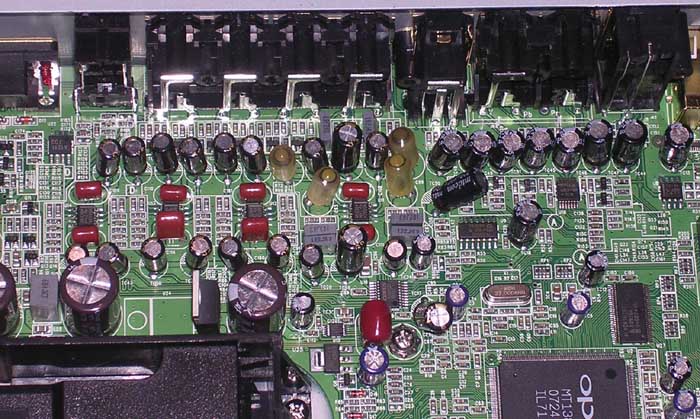
(Added 3/19/2008) The screenshots below show the CD playback interface and the SACD playback interface. The CD playback shot shows the default background image as well as CD text (the disc must provide the CD text data). The SACD playback interface is shared with the USB interface and CD-R/DVD-R data discs.
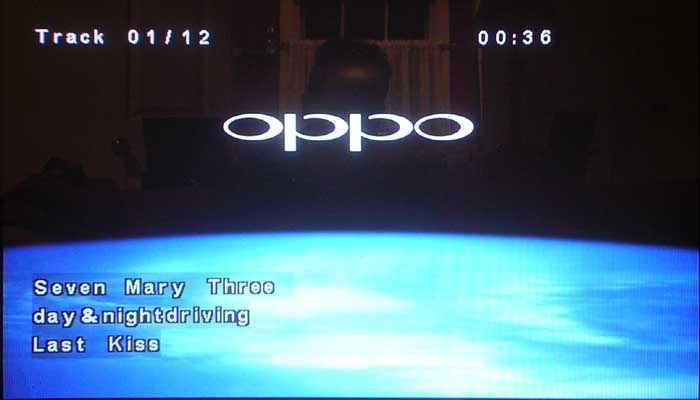
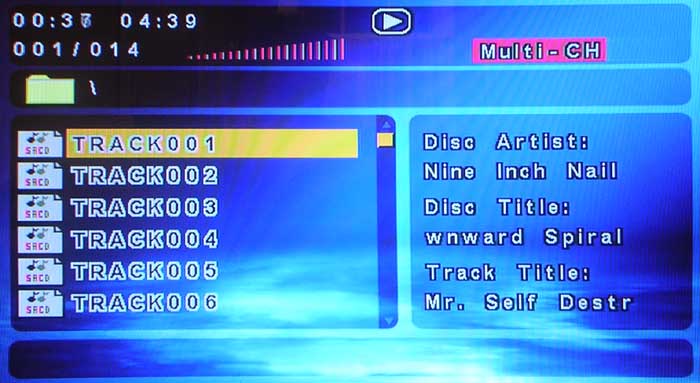
DV-983H on-screen display – SACD playback
Aside from testing different processing modes, I used the analog output primarily for DVD-Audio and SACD. Having spent a fair bit of time with the 980H prior to using the 983H, I was already fairly familiar with the 980H's performance. The comments that I made about the 980H's DVD-Audio and SACD performance can be repeated virtually verbatim for the 983H. The two compare very closely. Sample discs such as Blue Man Group's "The Complex" (DVD-Audio), Telarc's "Great Film Fantasies" (SACD), Peter Gabriel's "Shaking the Tree: Sixteen Golden Greats" (SACD), and Metallica's Black album (DVD-Audio) all acquitted themselves well. I thought a bit about how I wanted to describe my opinion of DVD-Audio and SACD performance with the 983H. What finally occurred to me was something a bit less precise or technical than I wanted, but here it is anyway. There are times when I'll have a piece of equipment in the system and I'll feel that it is holding the overall system back. One clear example is when listening to MP3's with my Roku SoundBridge (although in that case it's less a matter of hardware and more a matter of compression in the source material). There was also a sense of this from my old Yamaha S1500 when listening to SACD's. I haven't felt this from the 983H with DVD-Audio or SACD. The player doesn't seem to be getting "in the way" or creating any sense of being an impediment to the music. You could get better analog output for DVD-Audio and SACD, but you'll have to pay a pretty hefty premium for it, even with the 983H's relatively high price tag.
After over a year and a half of turmoil, posturing, and conflict, we have come to the end of the HD format war. As a side-effect of the war and Blu-ray's final victory, there has been something of a decline in effort being put into standard DVD players by some manufacturers. It is into that environment that OPPO Digital is introducing a statement piece: a universal DVD player with a potent video processing section and a bit more polish than earlier OPPO players. At a price point of $399 for a DVD player in 2008, it's clear that OPPO doesn't expect this to be a player that sets sales records for them (that's what the 980H is for). Instead, it has been developed as a flagship player, and in that role it excels. If you aren't ready to buy into Blu-ray or if you want a player that will wring the most performance possible out of your existing DVD library, the 983H is a player that could serve you well for many years to come.